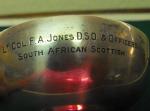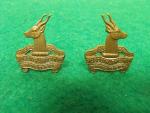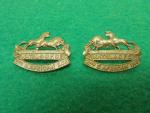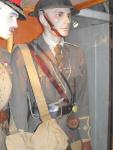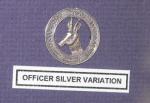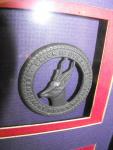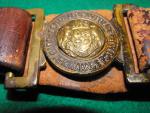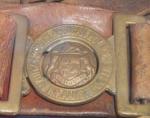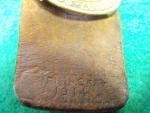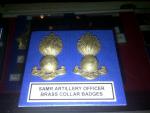
sabrigade
For Deletion-
Posts
1,707 -
Joined
-
Last visited
-
Days Won
33
Content Type
Profiles
Forums
Blogs
Gallery
Events
Store
Everything posted by sabrigade
-
Major Reginald Sergie Hunt was a senior officer in the 1st King's Dragoon Guards. On the 3rd of June 1911 he has been transferred to the Guards from the 3rd Hussars. In 1915, Hunt was the commander of B Squadron of the 1st Kings Dragoon Guards and was wounded on 31 May 1915 in "Zouave Wood" as his squadron entered. His connection with the S.A. Scottish is not confirmed but I am of the opinion that he may have been a training officer attached to the Brigade when they arrived in November 1915 at the Bordon Camp. Hunt may still have been recovering from the wounds that he had received in France. Hunt went on to command the 3rd RLR in France and was awarded a D.S.O. on 1 January 1918. After the great war, Hunt served in Iraq where he was also awarded the General Service Medal or GSM as it was known
-
In December 1915 it was decided to send the 1st South African Infantry Brigade to North Africa where the successful Senussi campaign was concluded and by the 15th of April 1916, they were in France. On 8 July 1916, the South Africans entered Bernafay Wood as part of the Somme offensive. On 11 July 1916, Lieutenant Colonel Jones was hit and killed by a shell splinter as he left his dugout in the Wood. His death came as a great shock to the regiment as he was the first senior South African officer to be killed in the campaign. Frank Aubrey Jones died at the age of 42 and was later awarded the CMG and was also mentioned in dispatches. He is buried in the Peronne Road Cemetary in Maricourt.
-
The 4th South African Infantry Regiment was formed as part of the 1st South African Infantry Brigade for service on the Western Front in France during the First World War. The member of the Regiment were therefore all volunteers and many of the officers and senior members were veterans of other campaigns and the then recently concluded German South West Africa campaign. The Regiment soon became known as the South African Scottish. The companies were formed from some established South African military establishments: A Company from the Cape Town Highlanders. B Company from the 1st Battalion Transvaal Scottish. C Company from the 2nd Battalion Transvaal Scottish. D Company was formed from the Caledonian Societies from the provinces of the Transvaal and Orange Free State. The honorary Colonel of the Regiment was Sir William Dalrymple who commanded the Scottish Horse during the Anglo-Boer War. The Regimental Commander was the very popular Lieutenant Colonel F.A. Jones, DSO. He was commonly known as "Fatty" to his officers and men. The Regiment was formed in Potchefstroom and proceed to England by ship where they disembarked in early November, 1915. Training then started in all earnest for France. A Scottish quiche is a two-handled drinking cup and the word "quiche" literally means "cup". A traditional Scottish item, it was used as a cup of welcome and also for a "farewell" drink which usually took the form of whisky or sometimes brandy.
-
The military cross
sabrigade replied to dcollect's topic in Great Britain: Orders, Gallantry, Campaign Medals
Top suspender? It looks complete to me. -
http://gmic.co.uk/uploads/monthly_04_2012/post-3034-0-81260600-1335193791.jpghttp://gmic.co.uk/uploads/monthly_04_2012/post-3034-0-96469900-1335193923.jpg 1st Sai Inf Regt officer collar badges on a uniform in my collection. The issue type are much thinner than these solid officer private purchase variations.
-
-
My great-grandfather, Burger William Wallace, fought on the side of the Boers against the British during the Anglo-Boer War. As a Scot, he was wounded at Spionkop and spent years as a P.O.W. on the then island of Ceylon. His ABO was turned into a brooch by my great-grandmother. He was part of the Irish Brigade.
-
Exceptional 7 Bar Group
sabrigade replied to Mervyn Mitton's topic in Great Britain: Orders, Gallantry, Campaign Medals
Hi Paul, Thank you, it is the Order of Merit, First Class. Regards, Will -
Exceptional 7 Bar Group
sabrigade replied to Mervyn Mitton's topic in Great Britain: Orders, Gallantry, Campaign Medals
Hi Mervyn, The original palace seems to have been destroyed after the fall of Khartoum. The meaning for the word Mahdi in Sudan varies from the "chosen one" to the "guided one". The Khalifa, or successor to the Mahdi, banned people from living in Khartoum and this lead to the rapid and unplanned expansion of Omdurman, the effects can still be seen today. The Battle of Omdurman is known as the Battle of Kerrari to the Sudanese. It is named after the series of hills which is quite a distance outside Omdurman. There is a monument erected by the Government to commemorate the 100th annerversary of the battle but it is difficult to access the area due to military installations surrounding the area. I am in Khartoum and will be transferred back here permanently soon. I have been awarded an Order by the Government of Sudan which I will be receiving soon and I hope to be in South Africa this week.





